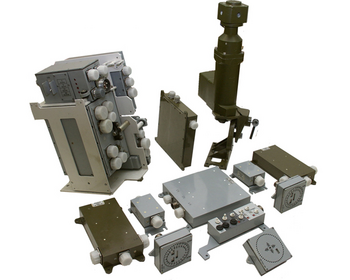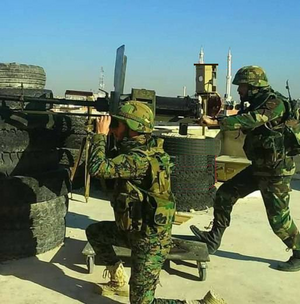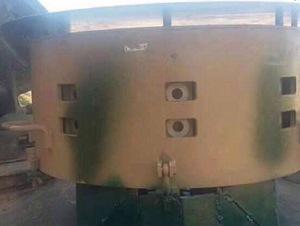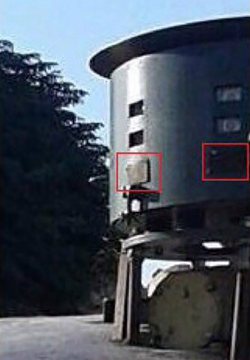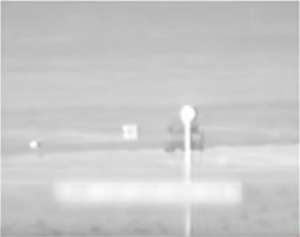Saraab active protection system
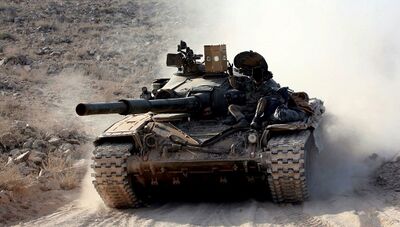
Saraab (سراب, Mirage) is a Riysian active protection system (APS) for protecting vehicles against anti-tank missiles, precision munitions, and guided artillery shells. Adopted some time in the late 1990s, it has since become widely available throughout the Riysian Ground Forces, due to its low cost and adaptable design. The estimated cost of a full system for a tank is $29,200, and its effectiveness against modern SACLOS ATGMs such as the TOW-2 or MILAN 3, is stated to be 80-90%, while its effectiveness against guided artillery shells is 70-75%.
It is mostly installed on tanks, but some of its components - primarily the optoelectronic suppression unit itself - can be installed on virtually any combat vehicle, and even fixed positions and trucks. This is possible due to the modularity of the Saraab system, which consists of several discrete subsystems that can be put together or swapped out as desired. At a minimum, a Saraab system consists of the Saraab optoelectronic suppression unit and a control panel; a full package adds a laser warning receiver, smoke laying system, and several displays for the crew.
Typically, Saraab is controlled by the tank or vehicle commander.
History
Experiences of the Riysian Ground Forces in the Unification War, as well as of other armies in conflicts through the 1970s and 80s, showed the vulnerability of even the best protected tanks to anti-tank missiles and precision-guided munitions. These technologies posed a very real threat in the minds of the Hay'at al-Arkan, which accelerated research in missile countermeasures, which eventually led to the concept of an active protection system. This first saw light in the form of the Nadi-1 defensive aids system, which combined the Nadi LWR with the Sadeem smoke launcher, and was subsequently augmented with an optoelectronic jamming system and computer to create the first generation Saraab-1 package. Much of the electronics design was done by Haraytan Mikroelektroniat.
When development of the Saraab began is unclear, but it seems that it was developed very rapidly, suggesting that work started in the late 1980s or early 1990s. Work on the system was finished some time in the 1990s, too late for the first batches of TR-96 tanks, but was soon included as standard equipment. Later on, most of the Riysian Ground Force's tanks, including older models in storage, were refitted with the package.
Design
Saraab consists of a central computer, optoelectronic suppression unit, and a control panel at its base, to which additional subsystems can be connected or swapped out. The digital computer is the centerpiece of the APS, where it interprets commands from the control panel, manages and directs the active components and countermeasures, manages the built-in test equipment, and outputs information to any connected displays. Though modular, the Saraab APS is not based on an open architecture, so only a limited range of systems can be coupled to the system's computer.
From his station, the commander uses the Saraab's control panel to operate the APS. Sections of the panel are color-coded to help with memory; the light-grey right side contains switches and lights for the suppression unit, the left side controls the Sadeem smoke launchers, and the dark-grey middle section is for turning the system on/off, controlling the laser warning system, and diagnosing faults.
In addition to the control panel, there are three displays associated with a full Saraab system - one for the commander, gunner, driver. Both the commander and the gunner get a main display, indicating the direction of the laser or radar irradiation source, the type of laser detected (eg. rangefinder, designator, and if the source is vertical), the suppression unit's status, the status of the smoke grenade launchers and number of grenades left, and the operating mode with diagnostics results. The driver's display also shows the direction of the illuminator, and offers directional indications for avoiding the threat and moving under the cover of smoke, based on environmental data from a mast.
As of 2020, there are four known Saraab packages deployed:
- Saraab-1: First generation optoelectronic suppression unit, NIL-D Nadi LWS, and RDD-1 Sadeem smoke grenade launchers. Largely created from the adding of the suppression unit and computer to Nadi-1 systems.
- Saraab-2A/B: Second generation suppression unit, NIL-D Nadi LWS (A) or NID Shaa'a TWS (B), and RDD-1/RDD-2 Sadeem smoke system.
- Saraab-3: Third generation suppression unit, NID Shaa'a TWS, and RDD-1/RDD-2 Sadeem smoke system.
- Saraab-4A/B: Second or third generation suppression unit, NID Shaa'a TWS, RDD-1/RDD-2 Sadeem smoke system, and passive laser deception system. Existence confirmed in 2020, refers to earlier packages supplemented with the passive laser jammer.
Saraab optoelectronic suppression unit
The main and most visible component of the active protection system is the optoelectronic suppression unit, or simply the infrared jammer, which is also believed to be designated "Saraab". Nicknamed "hats" or "birdhouses" due to their shape and location on the tank, Saraab jammers work by radiating pulsed infrared light, mimicking the missile tracking beacons found on SACLOS missiles. This causes the firing post's computer to reject the missile in favor of the jammer, which leads to the missile losing guidance or being fed erroneous commands. Three generations of Saraab suppression units have been produced, and a fourth generation may be in active testing.
First generation jamming units entered service in the 1990s, creating the Saraab-1 APS. Comparable to other missile jammers such as Shtora or the AN/VLQ-6, the Saraab-1 suppression unit uses a set of four infrared lamps with magnifying lenses, covering approximately 180° in azimuth and 45° in elevation. The suppression unit could run on battery power for up to 6 hours, with a service life of 1,000 operating hours, and had a single generic emission pattern covering a wavelength of 0.7 to 3.0 microns. Though the first generation units have been replaced on Riysian vehicles by newer models, they have found new life as standalone jammers protecting infantry positions, trucks, and other soft targets.
Second generation Saraab jammers appear to have entered service in 2004, with a radically changed appearance. Instead of the tall paneled housing of the previous generation, Saraab-2 jammers have a much more stout hemispherical casing, improving visibility, and is also armored to increase its survivability. The infrared lamps were replaced by two banks of light diodes, which increased the battery life to 10 hours and nearly doubled its service life to 1,800 hours, while retaining the same coverage as the first generation. Newer electronics and a more powerful computer allow for a highly flexible, responsive jammer to counter frequency-agile beacons found on some of the latest missiles.
The use of two rows of LEDs is believed to be a direct counter to the TOW-2's more advanced guidance system, which uses a LWIR thermal beacon in addition to its main NIR xenon beacon. By adding the upper bank, the jammer covers the 8 to 12 micron thermal imaging band, in addition to the standard 0.7 to 3.0 microns, more effectively suppressing the TOW 2 command link. Four operating modes were added to the jammer, making use of its increased effectiveness and frequency agility.
- Mode T uses both diode banks, and is intended to be used against the TOW family and similar anti-tank missiles.
- Mode R uses the standard NIR LEDs with a pulse frequency tuned to best counter Combloc-type missiles, such as the Konkurs and HJ-8.
- Mode A is a generic mode that also uses only the standard LEDs.
- Mode Kh is a spare mode, programmable at the depot level to counter threats not effectively covered by the other three modes.
As of 2020, this is the most common generation of optoelectronic suppression unit in service.
The third generation Saraab jammer was first spotted in 2016 and has since largely remained hidden from public view, seemingly being only used by TR-96 tanks. Externally, it resembles the Saraab-2 jammer, but has nearly 360° of coverage, as well as a third bank of square panels located under the NIR LEDs. It is believed that these are laser emitters, which jam anti-tank systems by blinding the optical systems of its launcher. Primarily intended to jam threats not vulnerable to the IR deception jamming, these emitters can be automatically activated when irradiated by a threat, or semi-automatically with the crew deciding what sectors to fire on and when to emit.
How it likely works is by first using an ultra-low powered laser to detect threat optics in its sector, then generating and directing an electronically shaped, high energy laser pulse onto the target. Such a pulse would damage electro-optics and blind the operator for several seconds at a time, preventing aimed fire at the vehicle. The inclusion of laser emitters does not adversely effect the cost-effectiveness or adaptability of the Saraab system, as its operating principle is not complex or costly to implement, especially with modern electronics.
Aside from that, the Saraab-3 features more advanced IR jamming patterns than the Saraab-2, as well as the significantly improved protected arc. Reliability is also likely improved.
Before developing the recognizable "birdhouse" design of the Saraab, a prototype dazzler system was trialed on some tanks. This was a simple IR dazzler mounted next to the gunner's sight, only covering the forward arc of the tank. It does not appear to have been a successful design, as it was never mass produced and soon replaced by the Saraab-1.
NIL-D Nadi laser warning system
Entering service in 1985 with the TR-83AM, the NIL-D Nadi (ندى, Dew) is the first Riysian tank laser warning system, and also a component of the first Riysian tank protection system - the Nadi-1. A competitive LWS for its time, the Nadi can identify, determine the direction of, and characterize threats such as laser rangefinders, designators, and infrared searchlights (eg. OG-3U Luna). In 1988, the Nadi was upgraded to the NIL-D/1 model, which allowed it to also detect indirect laser radiation landing near the tank, through a secondary row of detectors.
The Nadi consists of four detector heads, covering a total of 360° in azimuth and from -15° to 45° in elevation, with an accuracy of 15°. Spectral range is from 0.4 to 1.9 microns, covering the most common types of battlefield lasers - FD Nd:YAG (532 nm), Ruby (694 nm), GaAs (870 nm), Nd:YAG (1064 nm), and Erbium-glass (1540 nm). Lasers landing within 2 meters of the tank can be detected with the basic Nadi, while the NIL-D/1 upgrade increases to within 10 meters. The Nadi is integrated with the tank's fire control system to prevent its own laser systems from triggering the Nadi, and a roof lock system will prevent smoke grenades from being launched while the hatches are still open, to prevent potential injuries to the crew. Three modes exist for the Nadi: automatic mode, where it will immediately face the turret towards the threat and launch a volley of RDD-1B grenades; semi-automatic mode, where it faces the turret in the threat direction but the crew selects and fires the grenades; and manual mode, where it will simply warn the crew of the threat.
Control of the the NIL-D and Nadi-1 system is accomplished through the NIL-D's main display, which is primarily operated by the commander, with a duplicate given to the gunner. This display indicates the direction of the laser threat, the time elapsed since detection, and the threat type (rangefinder, designator, infrared spotlight), as well as supporting diagnostics and built-in testing. Both different indicator lights and audio warning tones are emitted depending on the detected threat, along with if the threat is overhead - thus airborne - and if it was indirect. The status of the RDD-1's smoke launchers, as well as how many smoke grenades are left, are also displayed.
With the creation of the Saraab-1, the NIL-D's display was updated, taking the form used for the newer NID Shaa'a. This updated display shows the status and activity of the optoelectronic suppression unit.
NID Shaa'a tank warning system
Introduced in 1996 with the TR-96, the NID Shaa'a (شعاع, Ray or Beam) is a comprehensive tank warning system detecting both laser and RF threats, succeeding the NIL-D Nadi in service. It retains the four-head configuration of the Nadi, but uses new, completely passive heads connected to the central computer by fibre-optic lines, to minimize false alarms and increase reliability. Its has radically improved capabilities, including a greater spectral range, improved accuracy, the ability to detect radar emissions and beam-riding missiles, and a new LCD main display.
Coverage of the NID Shaa'a remains the same as the Nadi, but accuracy in the frontal 90° arc is increased to 5°; for RF/radar detection, the accuracy is 18° all over. Spectral range is improved to 0.4 to 11 microns, covering newer "eye safe" CO2 lasers, and the RF receiver detects from the X-band to the Ka-band/MMW. Added sensitivity around the 1 micron band allows for the detection of beam-riding missiles. Indirect lasing detection range is increased to 15 meters from the tank. A Real Time Interface (RTI) signal precisely captures the technical characteristics about the incoming laser signal, allowing for more accurate threat identification. The hatch locking mechanism is retained from the Nadi, as well as the three operating modes.
The defining characteristic of the new LCD display is a signals database located in EEPROM memory, which is easily loadable and re-programmable. Information from the RTI signal is compared against this database to determine what the threat specifically is, beyond the generic classifications of older LWRs. The memory of the display's computer stores information about the last 20 detected threats, which can be viewed by the operator. Like with the Nadi, the Shaa'a main display also displays the status of the smoke launchers and the number of grenades remaining, and the status of the optoelectronic suppression unit.
